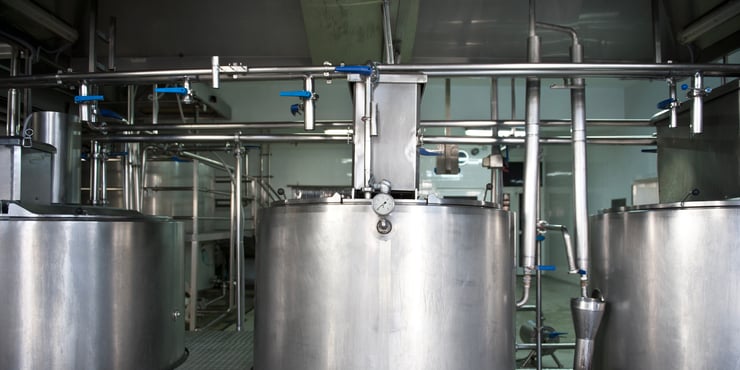“Where can you use centrifugal separators?” is a question that’s nearly impossible to answer. Centrifuge separation has applications across more industries than the average person can name — which would either make it a great or terrible question for pub trivia night.
These high-speed industrial champions are vital to the processing of dairy products, beer, wine, paint, mineral oil, petroleum, fruit juice, ceramics, plastics, animal feed, pharmaceuticals… the list goes on.
The managers of large industrial operations know that their centrifugal equipment needs to run efficiently, effectively, and reliably in order to keep production consistent. This leads us to an even more unlikely trivia question:
“How can you ensure a centrifugal separator is running at its most efficient?”
Though your rowdy bar crowd may not be able to answer this one, worry not — that’s why we’re here. In this blog, we’ll review how your centrifuge equipment works, then offer you insider tips to ensure your equipment is running as efficiently as possible.
How does centrifugal separation work?
Whether you’re using a centrifugal separator for milk processing or for creating intensely pigmented paints, the fundamentals are the same.
A centrifugal separator is built with a high-speed rotational element inside, which spins in order to produce a centrifugal force several thousand times the force of gravity. This speeds up the separation of the liquid inside of it.
In a filtration centrifuge, the lighter or finer particles are separated and passed through a filter, while the heavier solids are discharged through a different outlet at the same time. In a sedimentation centrifuge, solids will collect in an imperforate bowl structure, and the lighter liquid will leave through an outlet passage.
In this manner, a highly efficient and continuous or near-continuous process allows for tens of thousands of gallons of processing per day.
Where might inefficiencies occur?
In any complex system, there are certain areas that are more likely to get a side-eye from technicians. Throughout the rest of this article, we’ll give you tips about what to keep an eye out for.
Inlet
There are several efficiency issues that can pop up here, the most important of which is feeding your equipment the correct amount by determining your actual flow rate.
Over- or under-feeding your equipment will both negatively impact production, so it’s important to understand your actual flow rate and how it compares to your rating. If actual flow rate and your equipment rating are in disagreement, this is a sign that you are not running at optimal efficiency.
If you are processing milk within a dairy setting, also be sure you are inputting milk at the correct temperature. If milk is too warm, it can unnecessarily increase your power bill, damage your equipment, and create excess sludge within the drum.
Valves
Valves work to maintain pressure inside the equipment and help control the flow of product.
Regular maintenance will keep valves clean and functional, but keep in mind that valves are adjustable, and should be tweaked for your particular process. If improperly set for your specific feed and flow rate, inefficiencies can crop up which could cost you tens of thousands of dollars a year.
Automation Controls
If your equipment is running on outdated programming, you’re likely flushing time and money down your outlet tubes. Automation technology is improving yearly in leaps and bounds, and optimizing your system to take advantage of these cutting-edge programs will undoubtedly increase productivity.
Update your automation to switch quickly between different products, with customized settings that will maximize efficiency. These will deter common issues such as burn-on, lingering solids, and unnecessary energy usage.
Separator — Disk or Bowl
At the heart of your liquid-solid separator is a disk or annular chamber bowl. Depending on your process and equipment, they may work in one of three ways.
Discontinuously: Centrifuges that must be stopped in order to remove solids by hand.
Semi-continuously: Centrifuges that temporarily pause themselves in order to self-clean.
Fully continuously: Centrifuges that can keep running by removing solids through nozzle-type separators.
If semi- or fully continuous production is possible but you are still working from a discontinuous system, you are stopping production more than necessary and leaving money on the table. Minimize downtime and get a leg up on competitors by upgrading your equipment.
Keep on top of maintenance.
Even when each specific part of your centrifuge is working well, your equipment still needs to undergo regular maintenance (usually twice a year) in order to run efficiently and ensure its lifespan.
Maintenance is key. The longer you leave it, the more expensive it can get, so it’s best to schedule maintenance regularly to coincide with factory downtime. At Separators, we have the resources and experience to help you keep your separation equipment in its best shape.
Also, consider the staff side of things.
When thinking about maintenance, it’s easy to stay locked into a purely mechanical mindset. But the truth is, employees are a huge factor in driving efficiency.
Everyday operational tasks are people-driven activities. And when an operator knows what to look for, they’re much more likely to catch early signs of inefficiency and help you course-correct.
It comes down to this: if your employees aren’t trained in basic centrifuge principles, you risk operational errors and wasted time and money.
Stay efficient to stay profitable.
For your centrifugal separator to run at its most efficient, you needn’t always invest in huge overhauls or expensive new equipment. Rather, focus on the team effort of maintaining and running your centrifuge with diligent, educated operators.
We suggest investing in on-site training programs, customized to your needs. We offer programs that educate you and your staff about basic centrifuge principles, equipment start-up, maintenance, cleaning in place, valve adjustments, and automation, to increase the efficiency of production and minimize downtime.
We also provide on-site, regularly scheduled, and emergency maintenance from industry experts. We are reliable, quick, and here to keep your centrifuge running at its best.

